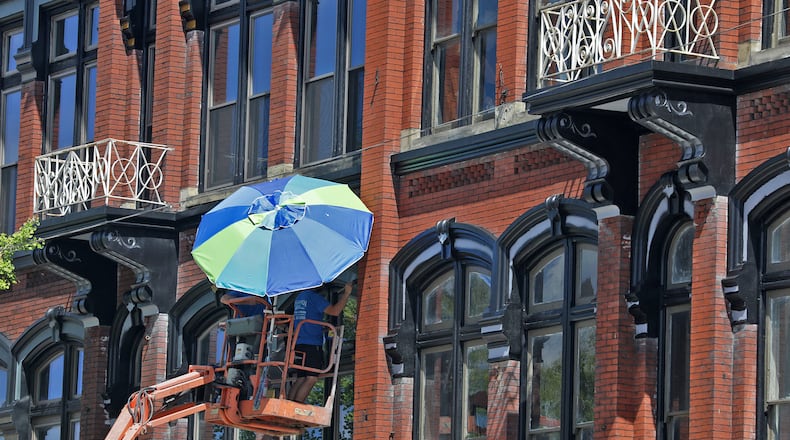The total budget for the project is $2.9 million, and a tax credit of $499,998 will be awarded to owner and developer Jamon Sellman for the rehabilitation of the buildings. Sellman said he also received an $800,000 grant from JobsOhio’s Vibrant Community Program, that is almost exclusively for co-work space development.
The 215 property, a two-story commercial building, and the 217 property, a three-story commercial building, originally were two separate retail spaces. The first floor was connected to each other in the 1950s, but they retain much of the “original character,” according to the Ohio Department of Development.
The property housed the former Willman Furniture buildings, which closed in late summer of 2022 after being open for decades. The property was purchased by Sellman through an LLC (Willman Sellman Improvements LLC) in February, said Doug Crabill, Urbana’s Community Development manager.
The building will be named the Willman Building and become a hybrid co-working and business incubator on the first floor called WillWork, with residential space in the upper two floors called Willman Lofts.
“The concept being that there’s a bunch of creative young professional types able to use common spaces,” Sellman said. “Urbana doesn’t have a co-working space, rooftop deck loft community. (We want to) change the narrative of the town, and include semi-premium living options.”
Sellman said there will be nine loft apartments, including one studio, four one-bedrooms and four two-bedrooms, a rooftop deck over the back section of the 215 building that will be a co-working accessible space, a new four-stop elevator, additional storage space in the basement, and a small café area.
The co-working space will allow individuals or businesses to join as members, and also offer daily or weekly memberships.
Along with the two buildings, Sellman is also rehabilitating the 219 address because the lower level expands from 215 to 219, but that it’s not part of the tax credit and involves his own funding.
Sellman said they are on a 12-month build cycle for the buildings, which is about 18,000-square-feet not counting the basement, and plan to start around Aug. 1.
Urbana was one of 16 communities across Ohio to receive awards, funded as part of the OHPTC Program and administered by the Ohio Department of Development, that total $50.5 million in tax credits.
The state support was announced last week by Ohio Gov. Mike DeWine, Lt. Gov. Jon Husted and Ohio Department of Development Director Lydia Mihalik for 38 historic preservation projects that will rehabilitate 59 historic buildings across Ohio. The projects are expected to leverage $523 million in public and private investment.
“Ohio’s history is rich with innovation,” DeWine said. “Many of these buildings were once home to the factories, shops and offices that drove Ohio forward, and they still have a place in Ohio’s future. We are excited to help revive these historic structures so they can once again be a valuable part of their communities.”
The awards help private developers in rehabilitating historic buildings in downtowns and neighborhoods, in which many are vacant and generate little economic activity. Once rehabilitated, they will drive investment and interest in adjacent property.
The developers are not issued the tax credit until the project construction is complete and all program requirements are verified.
“Historic preservation is at the heart of opportunity across our state,” Mihalik said. “By revitalizing our historic assets, we’re bringing new life to and invigorating our downtowns, and creating hubs for economic activity across our state.”
Crabill said investment by one leads to the investment by others, which is what is happening in downtown Urbana.
“In total, over 50 new residential units have been constructed, proposed or are under construction with downtown Urbana within the last five years with investment in multiple buildings and by multiple property owners,” he said. “Beyond the residential development, first-floor spaces that were formerly offices are being repurposed for retail and restaurant spaces, which is leading to increased foot traffic and retail sales downtown.”
About the Author

